INITIATIVE GADSDEN
A NEW GENERATION OF PHILANTHROPISTS
+Investing for Good AN IMPACT-FOCUSED APPROACH
Community
SPARK FUNDS: IGNITING IDEAS FOR CHANGE

Program
EVOLVING AN INDIGENOUS-LED GRANTING PROCESS


+Investing for Good AN IMPACT-FOCUSED APPROACH
Community
SPARK FUNDS: IGNITING IDEAS FOR CHANGE

Program
EVOLVING AN INDIGENOUS-LED GRANTING PROCESS

Last October, The Victoria Foundation released its 18th edition of Vital Signs, a data-driven community checkup on the vitality of our region. The theme was “From Hope to Change,” and the report was based on over 5,000 survey responses from community members who care deeply about our collective wellbeing.
That record number of responses reminded us that hope is one of the most powerful tools we have. Now, thanks to our generous and innovative community, this issue of Pulse highlights the change our region continues to work tirelessly toward.
In these pages, you will read stories that expand on the theme of moving from hope to change — stories of people who are building community by taking care of each other. This means taking care of our families and friends, our environment, our shared home, and most importantly, our collective future.
You will read about people investing in social impact initiatives to build community in Greater Victoria. We have a story of a wonderful couple supporting the community by leaving a legacy for women’s equality in their Will. You can also read about the Indigenous Granting Advisory Pilot — a major step in philanthropy that puts granting power into the hands of local Indigenous leaders.
These successes, among many others, show how we’re building community by taking care of all aspects of our collective wellbeing. We hope you enjoy this edition of Pulse, and we look forward to sharing more stories that will resonate with you, throughout the year, on our website and social media.
 Sandra Richardson Victoria Foundation CEO
Sandra Richardson Victoria Foundation CEO


The capital region is home to a rich diversity of Indigenous peoples and cultures. Based on the 2021 Census, there were an estimated 19,460 individuals in the Victoria Census Metropolitan Area (CMA) who identified as First Nations, Métis, and/or Inuk (Inuit). We acknowledge with respect the Lekwungen-speaking people of the Songhees and Esquimalt Nations on whose traditional lands our offices are located.
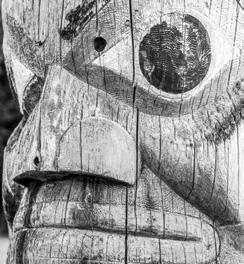
At the Victoria Foundation, we believe in connecting people who care with causes that matter ®
#200-703 Broughton Street
VICTORIA FOUNDATION
#200-703 Broughton Street, Victoria British Columbia, V8W 1E2
Victoria, British Columbia, V8W 1E2
Tel 250.381.5532 Fax 250.480.1129
Tel 250.381.5532 Fax 250.480.1129
info@victoriafoundation.bc.ca | victoriafoundation.ca
Charitable BN 13065 0898 RR0001
info@victoriafoundation.bc.ca victoriafoundation.ca
Charitable BN 13065 0898 RR0001
BOARD OF DIRECTORS
Patrick Kelly, Chair
Tamara Napoleon, Board Chair / Rob Gareau, Vice-Chair
Kyman Chan, Treasurer
Rasool Rayani, Past Chair
of Pulse takes a look at these connections through the eyes of some of the region’s oldest
the Foundation’s vision to build a vibrant, caring community for all
Karen Cameron, Treasurer / Rajiv K. Gandhi, Past Board Chair
Dr. Hannes Blum / Brad Clark / Teresa Lin / Wency Lum
James Darke, Karen DeMeo, Mia Maki
Marilyn Sing / John van Cuylenborg / Ruth Young
Mar y Mouat, Carey Newman, Ian Wong
Grace Wong Sneddon, Deirdre Roberts, Honorar y Governors President
SPECIAL ADVISORS TO THE BOARD OF DIRECTORS
PULSE MAGAZINE is published by
Patrick Kelly, Indigenous Cultural Advisor / Dr. Grace Wong Sneddon, Honourary Governors President & Advisor
Most photos by Derek Ford, unless otherwise stated.
580 Ardersier Road, Victoria British Columbia, V8Z 1C7
Tel 250.595.7243
info@pageonepublishing.ca pageonepublishing.ca
Since 1936, these relationships have resulted in grants totalling more than $163 million to charitable organizations and scholarship recipients in our region and beyond And with current assets under management at an alltime high of over $270 million, the Foundation is poised to continue granting well beyond the next 80 years
As the region’s largest non-government funding organization, we ’ re proud to be able to support an amazing breadth of issues and causes. Within the pages of this issue, you can read about the remarkable work of a number of recent grant recipients, including the Aboriginal Coalition to End Homelessness, the Victoria Community Food Hub Society, the Raincoast Conservation Foundation and more
Articles written by Gillie Easdon and Victoria Foundation staff.
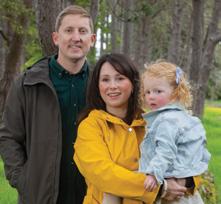
Danielle Stevenso Coordinator for the Coalition of Neighbourhood Houses. Photo by Simon Des
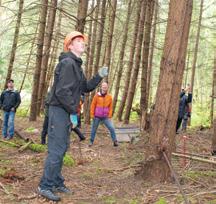
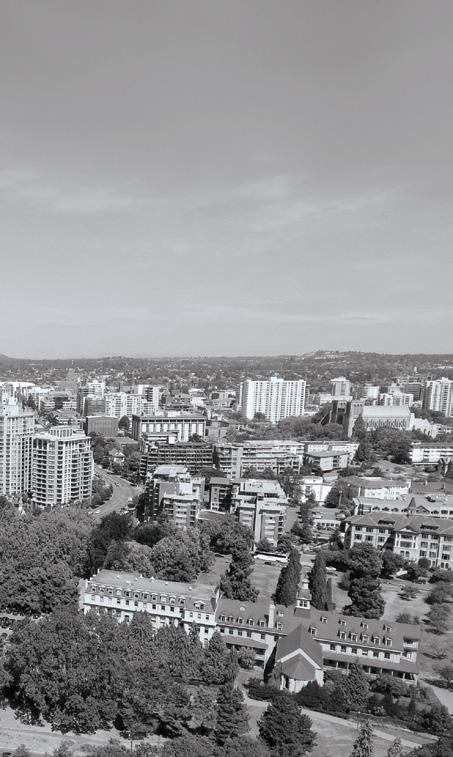
Loans, to inspirational donors and the professional advisors who help bring their philanthropic dreams into reality ticles on the following pages will be both informative and ivating you to begin or strengthen your own involvement in ng with causes that matter most


Being responsive to the communities the Victoria Foundation serves means engaging in important conversations, listening to learn, and being open to evolving processes. The Indigenous Granting Advisory Pilot emerged from the Board’s 2022 Reconciliation Task Group. Comprised of local nation members and Indigenous people living on the South Island, the Advisory reviews and recommends applications for the Indigenous Priorities Fund.
The Indigenous Granting Advisory’s Guiding Principles:
› Good mind and good heart
› Work and collaborate in a good way
› Rethink ways of doing, especially around granting
› Walk and learn with humility
› Be reflective
› Be proactive and responsive
The purpose of this fund is to support social, cultural, and legal infrastructure for Indigenous communities in the capital region. Developing new avenues for supporting Indigenous communities is fundamentally important to reconciliation. This new initiative builds on the Victoria Foundation’s ongoing relationship with Indigenous communities and recognizes the need for this process to be Indigenous-led.
The new Indigenous Granting Advisory Pilot distributed $506,000 to four local Nations and 13 other organizations. The Esquimalt Nation, SȾÁUTW̱ (Tsawout) Nation Head Start program, and The Literacy Circle Society with the Victoria Native Friendship Centre were recipients.
“The process (is now) more streamlined and feels more empowering. Often, we are shoehorning into what a grant can offer versus fitting our needs within a grant.
The Pilot is very Nation-centered and feels more about meeting the needs of the community,” shares Kalie Dyer, Director of Education, Esquimalt Nation.
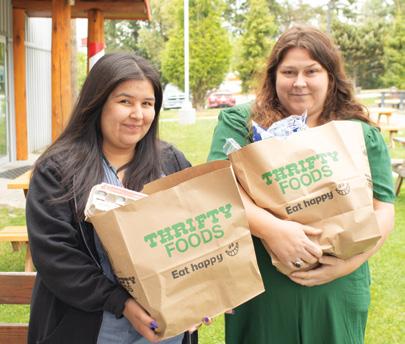
They received $38,598 to hire an employment and education navigator to support Nation members in attaining personal, educational, and employment goals. The collective need for this new position emerged from the Nation’s education advisory committee discussions and their work creating an internal post-secondary policy manual.
Dyer and her colleague wear many hats for the small Esquimalt Nation. Connecting, supporting, and finding out an individual’s goals takes time. “The biggest gap is community members having difficulty navigating external systems. Having someone internally who is encouraging and responsive to the individual who is part of the community is a game changer. They can get to know the person, hang out, be present to walk alongside the person throughout their education or employment journey, and track community needs. That core relational component is key.” This position will “facilitate skill-building and support people to take charge of their goals, and enhance the community’s self-sufficiency.”
The founding Indigenous Granting Advisory Pilot group members for 2023 include Margaret Charlie, Songhees Nation Council Member; Ruth Young, Cree Nation of Wemindji, Director, Indigenous Initiatives, UVic Law, and Victoria Foundation Board Member; Tamara Napoleon, Saulteau First Nations, Co-leader
VICTORIA’S 70% of survey respondents agree that there should be more opportunities to support cross-cultural education and awareness. victoriafoundation.bc.ca/vital-signs
and Principal Lawyer, Miller Titerle + Co's Indigenous Law Group and Victoria Foundation Board Chair; and Charla Huber, First Nations and Inuit heritage from Fort Chipewyan, AB, Indigenous Consultant and Instructor at Royal Roads University. Together with Victoria Foundation staff they developed this Advisory group’s structure, values, and priorities and the Indigenous Priorities Fund. “We talked about our values and how we are doing that work, walking and learning in humility. We want to be responsive and proactive — the next level of trust-based philanthropy,” shares Young.
“The Victoria Foundation has done a really good job ensuring organizations and nations are informed about the grants rather than expecting the communities to seek opportunities. This included visits to Nation offices to ensure the granting procedure is more accessible, dynamic, flexible, and inclusive.” Some grants were delivered orally. Indigenous communities and organizations were invited to an inaugural Victoria Foundation open house to ask questions and strengthen grant requests. This new approach asks, “What are your gaps? How can we fund those areas so your nation or area can thrive? It’s a beautiful thing to be part of. It really is about highlighting the strengths of community and meeting them where they’re at. It creates opportunities for conversations and building relationships…and ideally does not create more labour.”
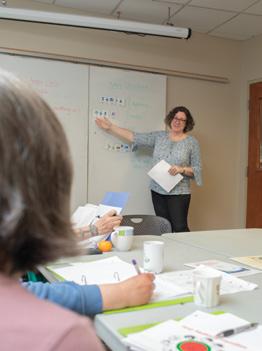
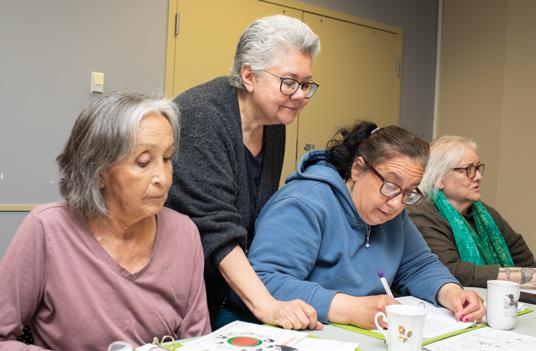
The Literacy Circle provides “English literacy skills through storytelling in a supportive, safe, and self paced environment” for Indigenous Elders and adults, residential and day school survivors, and intergenerational survivors. In Nanaimo since 2021, The Literacy Circle with Victoria Native Friendship Centre received $10,000 for a Victoria pilot.
The Literacy Circle Executive Director Mary Desprez reflects, “It takes bravery to return to a classroom. You need to build that trust — we're blessed to be with a powerful group of learners.” Some learn to read and empower their grandchildren to stay in school. “Many students want to learn how to read recipes, their medication, etc. One is learning basic math because she was worried about not getting the right change from stores. There are still disturbing attitudes around Indigenous people. Many are, sadly, used to being ripped off.” Retired teachers lead the classes after completing San'yas Indigenous Cultural Safety Training.
The classroom is more than just a place to learn reading, writing, tech literacy, and math. It’s a safe space for people to bring up other issues they may face — like a landlord forcing an illegal eviction, for example. “Other learners want to write their stories, to leave a legacy. We will create chapbooks of the stories they can share with their families so their history is not forgotten.” Desprez adds, “I’m grateful
to the Victoria Foundation. They are the most forward-thinking people I know. Now, a class means something different.”
Transportation is vital when delivering SȾÁUTW̱ Head Start’s programming. For Amber Cunningham, SȾÁUTW̱ Head Start Coordinator, the $38,598 received for a van means family field trips, land-based learning, cultural programming, and access to services. Cunningham has been managing the milk, eggs, and produce delivery program from her car. “The van will be equipped with the appropriate car seats to help make this service less stressful for our community parents.”
SȾÁUTW̱ Head Start is part of Aboriginal Head Start On Reserve, a program for families with kids up to age 6 that focuses on family involvement, nutrition, education, social support, and culture and language. The van will increase home visits and facilitate helping Nation members navigate services. “(The van) eliminates the transportation barriers of living in a remote community. Bussing services often run once an hour, with the nearest grocery store over 2 km away.”
The Indigenous Priorities Fund and the Indigenous Granting Advisory Pilot are part of the process toward more inclusive and effective community engagement. Indigenous voices and needs are heard and acted upon by listening and having timely conversations. This evolution fosters a deeper understanding of and collaboration with Indigenous communities and builds community. n
$533
M I L L IO N I N A SS E T S under administration including 42 new funds
7.5% INVE S TMEN T RETURN S ten-year annualized investment returns
1,887 G RA N T DI S TR I BUTION S All grants paid to registered charities or other organizations in accordance with CRA regulations
$27+
The Victoria Foundation continues to strengthen community wellbeing by investing in people, opportunities, and solutions. As of the end of 2023, the Victoria Foundation has granted $340 million since our inception. Starting from humble beginnings with a $20 gift from Fannie Gadsden, the mother of our founder Burges Gadsden, the Foundation continues to work to create a vibrant, caring community for all.
$60+ MI L L IO N I N G IF T S including bequest donations and gifts of securities
• $30 million endowment
• $18 million restricted term fund
• $12 million pass-through
• $120,996 unrestricted


5
to address to make Greater Victoria an even better place to live AFFORDABLE HOUSING / MORE RENTAL OPTIONS
SOCIAL ISSUES (including mental health, homelessness, etc.) IMPROVE PUBLIC SAFETY
FROM
The Victoria Foundation plays an active role in addressing the issues that matter to our community. Victoria’s Vital Signs is an annual community check-up, informed by a citizen survey, that measures the vitality of our region, identifies concerns, and supports action on 12 issue areas that are critical to our quality of life.
WHEN ASKED TO RATE THEIR OVERALL QUALITY OF LIFE, THE AVERAGE GRADE WAS
To read more visit victoriafoundation.bc.ca/vital-signs PRESENTING SPONSOR


The Vital Victoria Podcast, hosted by Lucky Budd, spotlights people who are working to create a vibrant and caring community for everyone in Greater Victoria and beyond. From wellness experts to performers, business innovators to champions for causes that matter, this monthly podcast captures the stories of wonderfully diverse, passionate people and the missions that motivate them all.

During each conversation, host Lucky Budd pulls in statistics from the Victoria Foundation’s Vital Signs program to dive deeper into the states of wellness in our region, and how Victoria’s vital people are working to address challenges so everyone can thrive. Listen to episodes at victoriafoundation.bc.ca/vital-victoria-podcast
Read more stories from our community throughout the year!
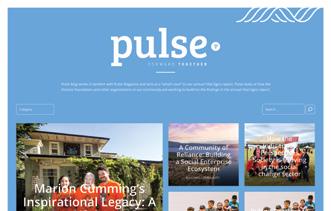
SOME STORIES INCLUDE:
› How the Indigenous Perspectives Society is Thriving in the Social Change Sector
Pulse blog is the companion site to Pulse Magazine and acts as a “what’s next” to our annual Vital Signs report. Pulse looks at how the Victoria Foundation and other organizations in our community are working to build on the findings in the annual Vital Signs report.
There are many great new stories to read so be sure to visit the blog regularly. victoriafoundation.bc.ca/pulse
› A Community of Reliance: Building a Social Enterprise Ecosystem
› Marion Cumming’s Inspirational Legacy: A Beautiful Act of Reconciliation

Victoria Foundation’s new nature-based climate action funding initiative granted $550,000 to 12 local environmental organizations and two local Nations. Invited to apply for up to $50,000 to protect, restore, and manage the capital region's terrestrial, freshwater, and/or marine ecosystems, priority was given to Indigenous-led, equity-deserving, community-led, or grassroots nature-based activities. The funding for this one-time initiative is from an individual through their estate.
Georgia Strait Alliance received $30,000 for Centering Communities in Biodiversity Protection and Climate Mitigation Planning for Marine Protected Areas. This funding advances how habitats are safeguarded by emphasizing a broader public understanding of marine planning and the need for increased community involvement. With three million Strait of Georgia residents, this project connects with government-led processes to balance economic, social, and environmental needs. It connects with marginalized groups often left out of discussions. “We’re learning to have conversations rooted in people’s lived experience.”
Nature-based climate action funding also supports the development of a more comprehensive understanding of Georgia Strait marine ecosystems and their role in mitigating climate impacts. This includes legislative tools and regulations for fishing, boating, and
protecting vulnerable species and habitats in marine protected areas, and supporting Parks Canada and First Nations’ co-management efforts. “The grant enabled us to hire staff and helped leverage additional funds,” says Christianne Wilhelmson, former Executive Director of Georgia Strait Alliance.
Galiano Conservancy received $50,000 for Demonstrating Climate-Resilient Forest Restoration at Quadra Hill on Galiano Island. This community-based land trust and environmental charity works to protect, steward, and restore Galiano Island ecosystems by creating a network of natural areas. They hold title to 281.5 hectares of protected land, including 47 hectares at the newly created Quadra Hill Nature Reserve. They also hold conservation covenants on 211 hectares and perform land management activities on a further 100 hectares of protected lands owned by the Crown and other conservation organizations.
VICTORIA’S
According to survey respondents, 4 of the 5 best things about Greater Victoria are nature-related: the natural environment, climate, air quality, and parks.
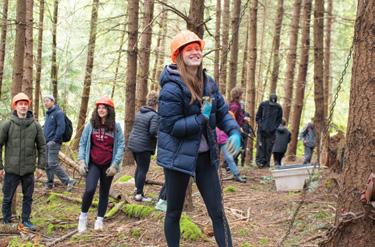
victoriafoundation.bc.ca/vital-signs
Our mission has always been protecting the health of the Salish Sea and its communities. Now, they are also mitigating against climate change.
— Christianne Wilhelmson, former Executive Director, Georgia Strait Alliance“Quadra Hill was the missing piece in our network of conservation lands. Our first goal is to safeguard carbon-rich ecosystems on the property. We want to take a simplified forest, a monoculture, and help it move toward a more complex one,” explains Adam Huggins, Restoration Coordinator, Galiano Conservancy.
Dense forests with the same tree species, age, and size form a contiguous canopy. The tree crowns interlock, and no light penetrates — plants and herbaceous species can’t grow. “It creates a situation that is very prone to fire,” clarifies independent biologist Keith Erickson (Galiano Conservancy’s Executive Director 2016-2020), “If there were an ignition, the trees would burn readily and intensely.” With widely spaced trees, a sub-canopy, and shrubs, forests have greater climate resilience. “When thinking about wildlife and habitat, we want layers and places to hide and ways for small animals to hurry up a bush to a small tree. We want to support a diversity of flowers, fruits, and seeds for birds and pollinators. That also translates to the ground and soil — complex above and below.”

Forest restoration involves culling trees. “How do you decide which tree to kill or cull? We look for ecological features, aka anchors in the surrounding forest, to help make these decisions. Is the tree beside a stump refuge to pre-logging soil fungi? Is it shading out a shrub we want?” Felled trees remain on the forest floor (“woody debris”) or are taken to nourish carbon-poor degraded wetlands. The plan includes improving relationships with Hul'q'umi'num'-speaking people on neighbouring Penelakut Island and hiring their fellers. Trees are felled with chainsaws but can be pulled over by hand with a chain hoist and pulley — much slower. “We are looking at that for a small section to host educational programs so visiting students can try pulling trees over safely.” This approach mimics windthrow with the upturned roots creating natural pit and mound structure on the forest floor.
These projects embody a more inclusive and holistic approach to environmental stewardship. Biodiversity, insights into local populations, and Indigenous practices are intertwined, creating resilient, sustainable ecosystems that help mitigate climate change impacts, ensuring the preservation of our natural heritage for future generations. n
Christianne Wilhelmson, Executive Director, Georgia Strait Alliance
Impact investing focuses on generating positive, measurable social and environmental benefits alongside a financial return.
Victoria Foundation began impact investing by creating an impact investing strategy and portfolio in 2018.
The initial goal was to move 5% of the Foundation’s Common Trust Fund into impact investments. In June 2023, the Board approved an increase from 5% to up to 15% over the next three to five years. Revenue generated from the Common Trust Fund endowment pool, valued at $422 million as of March 31, 2024, is what allows the Foundation to consistently and steadily increase the impact of annual distributions and grants into the community. The Common Trust Fund comprises the majority of Victoria Foundation's assets under administration. Other assets under administration are managed separately. Embracing this impact-focused approach to how we invest our endowment means Victoria Foundation can maximize how we utilize every financial resource we manage to address the health and wellbeing of our community.
“The Foundation invests in line with our values, and our investments are a catalyst for impact. As a community and as an organization, we are in a prime position to support great change. The greatest challenges of our time require capital to solve, and our endowment
helps us actively address the wicked problems of today. In 2023, the Foundation distributed more than $27 million through 1,800+ grants,” states Jessica Doll, Victoria Foundation's Associate Director of Impact.
“While we have a longstanding history of financially supporting the charitable sector with grant funding, we are looking for new ways to invest in social purpose organizations that help to grow social enterprise efforts in our region,” reflects Doll.
Federal initiatives, like the Investment Readiness Program (IRP), help social enterprises enhance their capacity to participate in the social finance market. Funded by the Government of Canada, the IRP provides non-repayable capital to help develop enterprises to a point where they can attract investment and participate in Canada’s growing social finance sector. This program is part of a broader effort to build a more inclusive and sustainable economy by supporting innovative solutions to social challenges.

My experience with Thrive Impact Fund (TIF) was unlike any other I have had with a lender. It was a very human experience. Their hearts are in the right place. It was perfect timing and certainly helped us to get where we are now.
— René Gauthier, EcologystEcologyst is a Victoria-based clothing factory and brand specializing in making legacy items from natural fibres. They received $50,000 in non-repayable funding from the IRP through Victoria Foundation. “It helped them move along their business life cycle so they could accept financial investment in their company to further their work,” shares Doll. “We directed $1.2 million to 45 social purpose organizations across Vancouver Island through the program.” Ecologyst used the funds to hire consulting and legal support, which enabled them to close a very successful financing round in early summer 2023. Gauthier says, “The people at Victoria Foundation were very helpful and responsive. We are very happy with the results.”
Born from the desire to “draw down carbon across our supply chain and bring apparel manufacturing back to North America,” Gauthier describes Ecologyst’s current transition to supporting larger brands. “We make things differently than most, with way less harm to the planet and people. But we want to expedite the change needed in our industry. We are realizing the value of our most important asset, supply chain, and our ability to make clothing in North America. We have been working to transition the business to offer what we do to other brands. It’s the next step.”
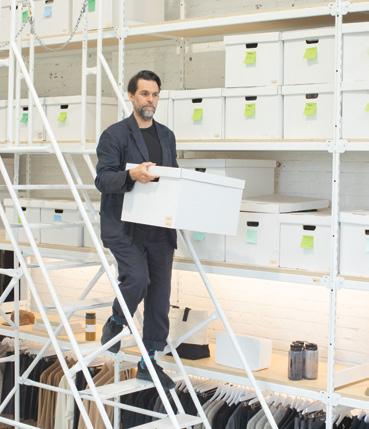
In February 2023, the Victoria Foundation made an initial investment in TIF of $200,000. As TIF grows, the Foundation is anticipating to increase its investment.
Ecologyst also received financing through Thrive Impact Fund (TIF). TIF is a Canadian, place-based impact investment fund designed to provide flexible financing solutions to social purpose organizations in British Columbia working to drive systemic social and environmental change. Managed by Scale Collaborative in Victoria and launched in 2020, TIF targets investments that offer financial returns and contribute to positive outcomes in housing, food security, environmental sustainability, and Indigenous-led solutions to create a resilient and inclusive economy.
Impact investments have already shown a lot of promise and enable the Foundation to start generating impact from our investments in addition to our grants. With the significant success of impact investing, we can accelerate community impact by using investments as tools for social change.
For more detailed information, you can read Responsible Investing 2023: Victoria Foundation’s Approach at victoriafoundation.bc.ca/publications n
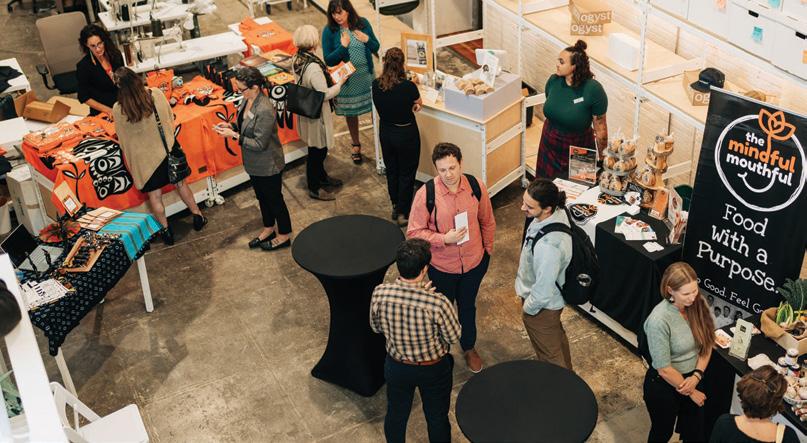
In an era of spiked living costs and crowdfunding to directly support friends and family in need, philanthropy for community causes can seem inaccessible. Our culture of busyness makes the prospect of even figuring out where to start quite daunting. The Victoria Foundation listened and designed the Gadsden Initiative to balance emerging donors' desire to contribute with the time-constricted realities of their lives. Its collaborative learning experience fosters a new philanthropy and a generation of inspired community leaders. The Gadsden Initiative offers a $5,000 match from Victoria Foundation to start their endowment fund. Gadsden members have three years to contribute this amount to their endowment fund to receive the match.
The Gadsden Initiative is a structured yet flexible program that involves collaborative core information sessions that cover such topics as values discovery, pooled granting, trust-based philanthropy, and trends in philanthropy. “Meet the Community” sessions connect members to the people on the ground to learn about key local initiatives. Past sessions at Foundry Victoria, the Mustard Seed Food Security Distribution Centre, and Power to Be have reinforced the significance and work involved at our local non-profits and charities.
67% of survey respondents named the natural environment as the best thing about Greater Victoria.
Our climate took second place, with 52% saying it’s the best thing about the region. victoriafoundation.bc.ca/vital-signs
VICTORIA’S
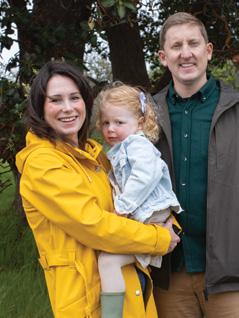
Members are also invited to Victoria Foundation events like the Donor Tea, annual Open House, Vital Youth Year End Celebration, and Vital Signs launch. Gadsden Initiative's framework ensures that contributions are impactful and that members have a clear understanding of the difference they are making in the community.
At the time of writing, there were 86 Gadsden members and 52 funds. Most of the Gadsden Initiative members are individuals or couples and people can join at any time throughout the year. Since 2019, more than $28,000 has been granted to charities in the Greater Victoria region. "Most of the funds have their core area of interest and members can come out to events and learn more. They are really interested in what is going on in the community," shares Tracey Trousdell, Gadsden Program Manager, and a member herself. The Gadsden Initiative was named after Burges Gadsden, who ran the soup kitchen in 1936 at the Sunshine Inn on Pandora, Victoria Foundation's birthplace. He knew this community would be improved by an organization with a solid source of funds to support charities across all sectors.
The Green Tithe Group is a Gadsden Initiative fund holder. These 13 elder millennial friends found themselves discussing their concerns and wanted to explore pooling their money to create meaningful change. Although they have a "wide variety of career paths within the group and a diversity of
Gadsden creates an inclusivity that is not always associated with philanthropy. We want to shift away from the idea of philanthropy as exclusive. There are a lot of ways that you can contribute.
— Tracey Trousdell, Gadsden Program Manager, Victoria Foundationfamily dynamics, we are all quite environmentally sensitive," explains Kelsi Langdon, a member of the Gadsden Initiative's Green Tithe Group. "I'm not the only one having climate anxieties. As part of this group, we have the same aim — we want to protect the environment for our futures." For Langdon and her friends, Gadsden Initiative's design works well and helps them "look at their lives in a collective way." Their group designated two people to attend sessions and report back. "Victoria Foundation has been really accommodating. They invite all of us to the events." Green Tithe has an established statement of purpose, and a minimum annual donation is required to qualify for a vote.
The Gadsden Initiative caters to individual emerging philanthropists and also welcomes groups, families, and anyone interested in making a difference. It accommodates varying levels of income and commitment, ensuring philanthropy is accessible and impactful. By pooling funds to reach endowment levels, members like those in the Green Tithe Group can provide sustained support for their causes, making a measurable difference in their communities.
The Gadsden Initiative represents a significant shift in how philanthropy is perceived and practiced in the capital region. It supports emerging donors to engage in meaningful philanthropy, ensuring they can see the tangible effects of their contributions. Gadsden members join a movement that addresses immediate community needs and prepares the ground for long-term, sustainable impact. n
Since its inception in 1936 in a humble soup kitchen on Pandora Avenue, the Victoria Foundation has dedicated itself to enhancing community wellbeing by investing in people, opportunities, and solutions.
Over eight decades, the Victoria Foundation has worked hard to earn the trust of individuals, families, non-profits, and businesses alike. Many turn to the Victoria Foundation to ensure they can contribute to their beloved Victoria in perpetuity.
Donor-advised funds that span generations are one of the ways people can leave a legacy that grows over time and furthers the support of causes that matter to them. The Victoria Foundation had an opportunity to discuss this with two adult siblings who manage an anonymous family fund started by their late parents. Their parents were religious and reserved, preferring a life of quality over quantity. As such, the siblings opted for anonymity in deference to their parents.
“Our dad was a businessman who worked hard: he arrived in Canada with a used car, a typewriter, camera, and a radio. He understood that money has value in creating more money and also the opportunity to be philanthropic through hard work or wise investing. They were not showy,” the son shares. “They always used the word stewardship — the money they had amassed was to be used for something other than frivolities,” adds the sister.
“At the end of every year, our dad would write out donation cheques. It was done very quietly.” When the parents passed, the inheritance was split between the two with a substantial amount also given to the Foundation to prolong the parents' vision for the fund and enable the siblings to make ongoing grant recommendations. The donation structure maximized the gift to the Foundation while minimizing taxation. Now, the siblings have more than $230,000 to grant annually. This gift not only preserves and increases the value of what their father had worked
so hard to earn but also continues the sharing. "We can support projects that particularly resonate.” Eventually, when both siblings have also passed, their trust fund will flow into the Foundation to further increase the philanthropic potential.
Twice a year, the two sit down to consider the causes that align with their family values and discuss how to allocate funds. They value the strength in their ability to be “a floodgate, not a trickle.” This legacy also empowers them to pitch in swiftly when there is a pressing issue. “The Victoria Foundation lets us know when there is an urgent need. It’s good to be able to respond to that.”
Through the legacy of their parents and the ongoing work of the Victoria Foundation, these siblings demonstrate the profound influence that thoughtful, focused giving can have on a community. Their story is a testament to the lasting value of quiet generosity and mindful stewardship. n
The recent Vital Signs citizen survey showed that 22% of tax filers in Greater Victoria made a charitable donation in 2021, compared to 17% of tax filers in BC. victoriafoundation.bc.ca/vital-signs
VICTORIA’SThis year, 2024, is unfolding to be another remarkable year for the Victoria Foundation. More people are eager to connect with causes important to them and to learn about our region's dynamic civil society sector.
There have been more conversations about the importance of this charitable sector, how challenging the work can be, and the need for more time, resources, and collaborations to make a lasting difference. We are grateful and honoured to have the support of our community as we look toward the future.
These ideas align with our new three-year strategic plan — a refreshed course of action that is propelling our community forward by being responsive to what we have learned over the years.
The Victoria Foundation seeks to create a sense of belonging that inspires philanthropy, collaboration, essential partnerships, and makes a lasting contribution to our community. We are working “on purpose” to achieve change.
This strategy is led by a diverse, forward-thinking Board of Directors who bring extensive care and expertise to our decision making. We’re honoured to have Tamara Napoleon as our Board Chair.
Tamara is a lawyer and member of the Saulteau First Nation, from northeastern BC. She co-leads Miller Titerle + Co’s Indigenous Law Group, and in 2020 was recognized as a Lexpert Rising Star — a leading lawyer under 40 in Canada.
She also serves as a board member for the BC Cancer Foundation and is the former Vice-President of the Aboriginal Mother Centre Society, among other distinguished roles. Her lengthy experience in Indigenous rights and non-profit leadership has been invaluable to advancing the Foundation’s mission.
Several key areas that reflect our purpose are by further embedding trust-based philanthropy in all our work. After all, our community’s organizations know better than anyone what they need to thrive.

We want to continue building this community trust through listening, learning, and actively using community knowledge in our work.
Collaborations are key to embracing innovative approaches to long-term solutions. They’re also crucial as we advance equity and share power with community members. For example, we’re deepening our Truth and Reconciliation work by expanding the scope of the Indigenous Granting Advisory Pilot, which builds on our ongoing relationships with local Indigenous communities and leaders.
The Foundation is also embracing a new energy — a generation of donors and investors who are more interested in impact investing, where their capital can make positive social and environmental impact alongside a financial return.
This is an excellent opportunity for us to collaborate and make meaningful change for generations to come; where purpose and profit are increasingly interwoven. The Foundation plans to invest up to 15% of the Common Trust Fund by 2026 in impact investing.
As we embark on our bold new plan, we are growing our own organizational capacity to be responsive to the community’s needs, ensuring our technology is up-to-date, and that we have the right tools to continue safeguarding privacy and cyber security.
Of course, our ambitious strategy is truly only possible because of you. Your ongoing generosity accelerates the Foundation and our community toward a better future.
Thank you for continuing to care deeply for the wellbeing of Greater Victoria and helping ensure no one is left behind. With your dedicated support, our region continues to become more vibrant and sustainable. n

The Vital Youth program enjoys its 21st year
Now in its 21st year, Victoria Foundation’s Vital Youth program has helped amplify youth voice and power in 12 schools across three school districts in the capital region. This youth-informed program supports students in discussing and pinpointing their values, researching critical issues, and choosing up to three charities to recommend to the Victoria Foundation Board of Directors for approval to receive $3,000 in grant funding.
Referencing Victoria Foundation’s Vital Signs Report, the United Nations Sustainable Development Goals, and the Truth and Reconciliation Commission of Canada’s Calls to Action, the Vital Youth program participants explore how to support their community. Victoria Foundation Director of Strategic Initiatives, Tracy Cullen, observes, “Today, youth are interested in being part of the solution. The Vital Youth program creates a positive way for youth to learn about the issues that are happening in their community, and to engage to make a difference.” In its first year of the program, Catherine Thijs, the Glenlyon Norfolk School (GNS) Vital Youth teacher-facilitator, remarks,
The Vital Youth program enabled us to connect to other students with similar priorities and goals. The program made me feel hopeful. We are on the right path, trying to figure out how to act to create change.
— Drishti Balaiah, Parkland Secondary, Second-year Vital Youth participant
“They really get to know the charities — become more critically aware. In the digital world, there is so much information students are bombarded with. It is inspiring to see them distill all of the information and observe how capable they are.”
“Until I was taking up those leadership roles, honestly, I felt a little bit hopeless. Our generation is dealing with a lot. Vital Youth opened our eyes to the people working on it and showed us we can make a tangible impact,” says Eden Andarge, Esquimalt High School, third-year Vital Youth program participant.
Every year, participating schools begin work with the program by forming Vital Youth committees within already established clubs or programs. Students work through the Vital Youth workbook and identify up to two student liaisons to attend site visits and all-cohort events. At Esquimalt High School, Vital Youth is part of the school leadership
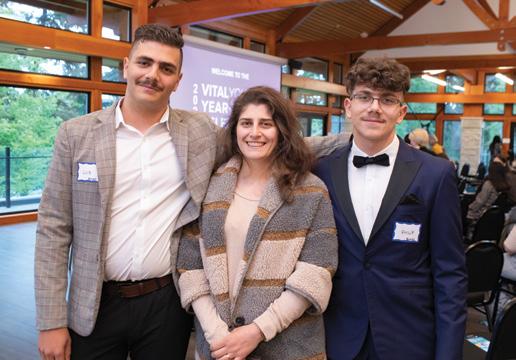
program. “But anyone interested can join. It’s good to have a mix of grades on the council. Then, when grade 12 students leave, they aren’t starting from nothing,” explains Andarge.
The Vital Youth program started in 2003, 21 years ago, with three participating schools. Now, there are more than 12 each year. "If every high school did this, that would be extraordinary. Kids take this experience with them. Vital Youth is not dependent on marks — it’s about empowering youth to feel and know they are making a difference in their community," states Thijs.
The Vital Youth program builds community by including and empowering youth, the leaders of tomorrow.
“There are not a lot of opportunities for youth and philanthropy,” observes Parklands Secondary and third-year Vital Youth program participant Sofia Vera. Some participants, like Andarge, Balaiah, and Vera, were raised in community-minded households. Even so, “it was a reality shock how many crucial issues are happening in our community. You don’t realize how close it hits home and, to you specifically — how many people are struggling. It motivates you to do more,” describes Balaiah.
The Vital Youth program also builds community by empowering youth to give back to non-profits that have made significant differences. In Esquimalt, the Rainbow Kitchen, a non-profit that strengthens food security, has furnished Esquimalt High School with a breakfast program, food baskets, and an open
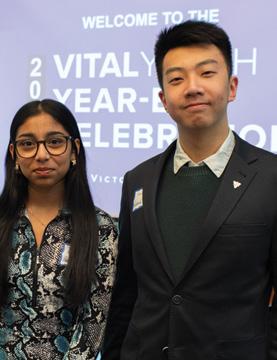
fridge that anyone can access whenever they need. Andarge reveals, “They got rid of the stigma around food scarcity. Before, not having certain things or not having the money was shameful. The Rainbow Kitchen created a safe and loving space to ask the office for food and breakfast. They created a really big change. I don’t have the words to explain the difference between how it was a few years ago.”
Through meetings with non-profits online or in person, Vital Youth participants decide which organizations are the best fit for their group's interests and values.
“We were invited to tour the Victoria Child Abuse Prevention and Counselling Centre by the Executive Director. It was such an experience. We fell in love with this organization. The interaction changed us — seeing where people go to get support and counseling, especially when they can’t afford it,” shares Vera. This critical service provider was in the process of relocating and expanding services, so the support, grant, and recognition were timely.
Vital Youth culminates in a celebratory event with youth presenting their committee’s journeys, the registered charity of their choice’s impact, and reflections over decadent desserts. Each cohort attends with Victoria Foundation staff, donors, board members, Honourary Governors, and community non-profit leaders. Connecting generations, values, youth, and organizations, Vital Youth is ready to meet the challenges of the future. n
Vital Youth participants
Vital Conversations help identify local solutions to challenges in our community; the Spark Funds move them forward
— Carol Hall, Senior Director, Innovation & Impact, Victoria Foundation
It takes more than conversation to create lasting change. In 2023, the Victoria Foundation introduced the Spark Funds, an innovative initiative that supports exploring solutions and cross-sector collaborations to address the key issues in our community. In line with the fund’s goal, the application and evaluation process is concise, swift, and efficient to ensure the “sparks” remain lit. Seven initiatives received $5,000, $10,000, or $15,000 of the $75,000 available funding. Coast Capital also contributed $20,000 in support of two projects.
Community Social Planning Council of Greater Victoria (CSPCGV) received $15,000 for community convening to further “digging into concrete solutions around housing and housing for all.” Executive Director Shelley Cook shares, “Spark allowed us to do several things we could not have been able to do.” Focused on building connected
Affordable housing and cost of living both ranked in the top 5 things to address to make Greater Victoria a better place to live. 76% of respondents said the availability of affordable rental accommodation to meet their needs is below average or poor.
victoriafoundation.bc.ca/vital-signs
VICTORIA’Scommunities within and across municipal boundaries, CSPCGV brought city councillors, non-profit executives, daycare providers, and developers together to establish “very concrete solutions.” Topics included creating affordable home access and ownership through municipal policy, financing, and development.
"CSPCGV also held a well-attended national webinar that showcased community response to homelessness based on a model out of London, Ontario," explains Cook.
One of the Spark Funds strengths is the trust it places in grantees. The Victoria Foundation recognizes the expertise of each charity and non-profit and supports the nimble use of funds. “It was hard to tell where the Spark Fund began and ended because it fed into a few key initiatives,” explains Cook.
Partnerships or collaborations among at least two organizations, preferably across sectors, are Spark Funds cornerstones. This approach acknowledges that organizations, businesses, and groups contribute distinct skillsets and tools.
“We want to build solutions and local agency to improve the community. Spark Fund seeds ideas that take that next step to discover what we can do and how we can do things differently. We don’t want to repeat old conversations. We want to get off the treadmill and build promising solutions together,” clarifies Hall.
In partnership with the University of Victoria, Scale Institute Society received a $15,000 Spark Funds grant for community-owned asset mapping. This involved researching and developing a comprehensive visual of community-owned (non-profit and municipal) land, buildings, and real estate in the Greater Victoria region to identify underutilized assets and/or those at risk for privatization.
Scale Institute Society conducted a broad-based asset scan and in-depth interviews with the people who manage/oversee them. “We wondered about the potential for existing assets owned by older non-profits that may be coming to the end of their
business cycle. What happens to the assets? Can we develop strategies around affordability and prioritize retention?” shares Kristi Fairholm Mader, Director, Innovation and Initiatives, Scale Collaborative (Scale Institute Society is the non-profit arm). Many of the 15 organizations interviewed voiced the need to divest assets when operations became too burdensome.
This mapping initiative revealed that many traditionally volunteer-run legions, churches, and community halls with an aging demographic “need renewal and require a different revenue-generating model to support that shift. Some can make that change, and some may not be able to. Organizations may need to transition, renew, or sunset — this change is hard.” Many assets are located on high-value land, and the property tax has become prohibitive. Also, when assets are new, they do not need much money to run; now they are older and require funds for upkeep and maintenance.
So, what solutions can Scale Institute Society further with this funding? “In partnership with Royal Roads University, we have been exploring creating a non-profit-owned real estate investment 'trust' in community-owned assets that allows us to get an economy of scale. Is there an appetite for that? Other solutions include social enterprises and business acquisitions where profits generated support non-profit programs and activities. It is important to try not to lose the assets — once they are gone, they are gone.” For Scale Institute Society, the Spark Funds fuelled the capacity to understand the problem. Their next step is to study the collected data and assess the appetite for change.
This first year of the Spark Funds has revealed the need and benefits of supporting further exploration of carefully considered ideas to evaluate their legitimacy and power. Some ideas may prove successful, and others may not, but “one of the many benefits of the Spark Funds initiative is that it acknowledges the need to try different ideas. By exploring innovative solutions and cross-sector collaborations, we can generate new ways of creating an affordable community for all,” reinforces Hall. n

After two long careers and 20 years together, Kirsten and barb are finally settling into a nice retirement life in Victoria. Their newfound freedom is giving them time to pursue philanthropy for causes that improve the lives of women – something they’ve grown passionate about through their former careers. For 33 years, barb worked as a teacher and for the teachers’ union in Manitoba. Kirsten spent most of her career as a labour relations officer with the Manitoba Nurses Union.
“These are women-based organizations,” said Kirsten. “Over the years, we really saw lots of areas of concern with how women are dealt with in the world and in their employment situations.”
Both saw firsthand just how unequal women can be treated, financially, socially, and otherwise, and they believe strongly in providing women with the resources needed to thrive. After moving to Victoria in 2015, they discovered a passion for philanthropy. And the mighty tool they’re using is their Will.
The pair turned to the Victoria Foundation to help them decide how to best use their Will for women’s equality.
The Foundation has partnered with Will Power, a national campaign encouraging Canadians to consider charitable giving when planning their estate. Even a small portion of an estate can make a big difference toward the causes of choice, while ensuring your loved ones are also supported.
Kirsten and barb believe that leaving a gift in a Will to a beloved charity is an effective way to establish a legacy for women long into the future.
“At a certain point in your life, you need to really think about what you want your legacy to be,” said barb. Kirsten is immensely satisfied that she and barb are using their Will Power to secure a future of possibilities for all kinds of women in the capital region who might not otherwise have the opportunities.
But women’s equality isn’t the only cause the couple are passionate about.
barb holds animal protection especially close to her heart. Supporting organizations that shelter, rescue, or rehabilitate wild animals is high on the list of charitable priorities.
They’ve also put their funds toward initiatives that tackle wealth disparity, including food insecurity, and low-income families.
Inspired by their philanthropy, Kirsten and barb are always quick to encourage others to give to whatever causes they care about. In fact, they jokingly say their friends are likely tired of hearing about it!
“Maybe that’s why the dinner invitations have dried up,” barb said, laughing.
To learn more about Will Power, visit the Victoria Foundation’s Will Power webpage willpower.ca/charities/the-victoria-foundation n
The Victoria Foundation lost a number of supporters over the past year. Our condolences go out to their family and friends. They will be missed.
Dr. Robert McArthur (July 2023) and his wife Norma established the Norma J. & Robert G. McArthur Fund to support people in need in Greater Victoria. Guided by their values of compassion and respect for others, Norma will continue to act as the donor advisor.
Donald Mills (December 2023) and his late wife, Margaret, established the Promise Fund, a designated fund to support food security and a bursary at the University of Victoria. Don also provided a gift in his Will to support post-secondary education for Indigenous youth.
Leland Donald (April 2024) established the Beth Stevenson and Leland Donald Fund in memory of his late wife Beth. The Fund will continue to support the causes that were important to them including fine art, support for guide dogs, children’s health, and hospice care.
Miroslava (Sally) Tyroler (July 2023) was a Victoria Circle member and named the Victoria Foundation in her Will to establish the Sally and Andy Tyroler Fund to support two local animal welfare organizations in perpetuity.
Elnora Wight (October 2023) was a Victoria Circle member and established the Tannis Wight Memorial Fund, a pass-through fund which will support three organizations that were important to Tannis.
Jane Bowers (October 2023) worked in the philanthropic sector so knew the value of giving back by leaving a legacy gift that will support both her family and her favourite causes. The Bowers Fund will be established to support the care, wellbeing, and health of animals, as well as cardiac care for patients in Victoria.
Sonia Erskine (December 2023) was a Victoria Circle member. Proceeds from her estate are to be used to establish the Per Ardua Fund, a designated fund to support three causes that were important to Sonia, in addition to the Foundation’s community grants program for homelessness programs and projects.
James Hughes (December 2023) provided a cash legacy gift in his Will which will support the Foundation’s strategic initiatives and other leadership and community engagement activities.
Bertha Goller (January 2024) provided a cash legacy gift to support the 9-10 Club Serving Soup to the Hungry, a pass-through gift through her Will.


John Harvey McEown lived a remarkable life in service of others. He passed away peacefully on March 29, 2024, just a few months after celebrating his 100th birthday surrounded by friends and family. Following his move from Manhattan to Victoria in 1986, John quickly became involved in Victoria's cultural and philanthropic endeavours, and he left behind a legacy of generosity that has made a lasting impact. Among his many accolades, John was an Honorary Governor of Victoria Foundation and an Honorary Life Member of the Boards of Our Place and the Victoria Symphony. In 2021, he received the City of Victoria's Honorary Citizenship Award for services to people experiencing homelessness. John was a long-time supporter of Mustard Seed, United Way Southern Vancouver Island, Broadmead Care, Threshold Housing, Parkinson Wellness Projects, Belfry Theatre, and Victoria Conservatory of Music. These are just a few highlights of John’s contributions. The funds he created at the Foundation will continue to support many worthwhile causes.
“John believed that people who are blessed with good fortune have an obligation to help those who face tough times. And he did this all his life. We are so fortunate that John chose to retire in Victoria,” says Sara Neely, Victoria Foundation’s Senior Director of Philanthropic Services.
John McEown (March 2024)

vibrant,
The Victoria Foundation inspires philanthropy and impact by helping people leave charitable legacies for causes that matter in the community. Since 1936, we've been managing generous gifts to create annual, income-earning funds for hundreds of non-profits and charities. To date, we've distributed more than $340 million, investing in people, opportunities, and solutions. Connect with us to learn more about our programs and initiatives. Let's nurture our future today, together.